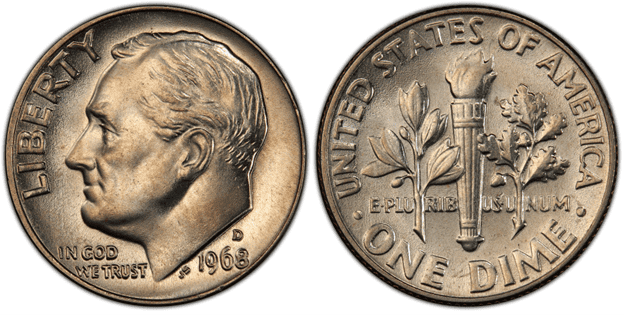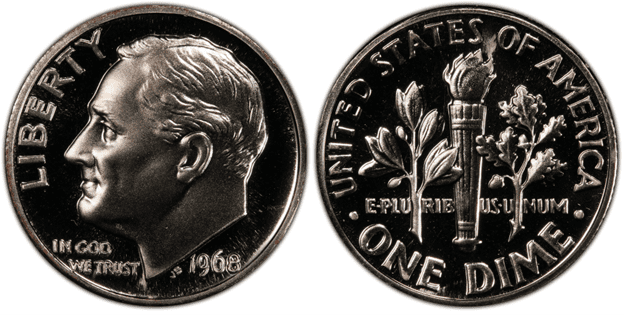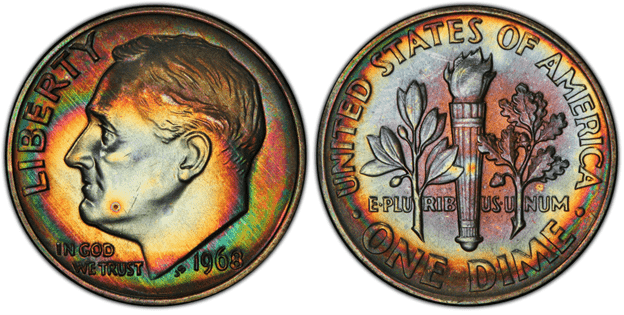What Is A 1968 Roosevelt Dime Made Of?
Since it first entered circulation in 1946, the Roosevelt Dime has served as a reminder of President Franklin D. Roosevelt’s support for the March of Dimes and his initiatives to end polio.
Chief Engraver John Sinnock came up with the design in 1945 after receiving a request from Congress to make a new dime. Sinnock’s design was debuted in 1946, taking the place of the earlier Winged Liberty Dime.
On the obverse a bust of President Roosevelt standing to the right dominates. The words “LIBERTY” and “IN GOD WE TRUST” can be seen in the right field and margin. The year of mintage and Sinnock’s initials are visible at the lower left of Roosevelt’s bust.
A flame representing liberty is part of the coin’s main design on the reverse. On either side of the flame, there is a single set of olive branches. The inscription “E PLURIBUS UNUM” appears between each branch and the flame. The phrases “UNITED STATES OF AMERICA” and “ONE DIME” are written above and below the image.
After silver was eliminated in 1964, the 1968 Roosevelt Dime is constructed of 75% copper and 25% nickel. This resulted in a 2.27-gramme weight and a 17.9 mm diameter. Reeding may be seen on the coin’s edge.
Roosevelt dimes, while being one of the longest-running circulating U.S. coin series, have gotten less attention from collectors than other varieties. This may be partially because the series lacks a significant rarity aside from a few variant coins or several low-mintage coins.
The mintage of Roosevelt dimes is often very high, starting at roughly 350 million for the 1946 P, D, and S coins and rising to as many as about four billion annually in the early 2000s. Roosevelt dimes are a workhorse circulating coin with a lower denomination.
While NASA’s Apollo 8 was in lunar orbit, the Boeing 747 jumbo aircraft made its maiden flight in 1968. Martin Luther King Jr. and Robert F. Kennedy, two peace activists, died concurrently with the sinking of the Navy intelligence ship USS Pueblo.
1968 Roosevelt Dime Varieties
1968-D Dime
Year: 1968
Face Value: $0.10
Composition: 75% Copper and 25% Nickel
Total Weight: 2.27g
Diameter: 17.91mm
Thickness: 1.35mm
Edge: 115 Reeds
Minted in: Denver
Quantity Minted: 480,748,280

photo source: www.pcgs.com
1968-S Dime
Year: 1968
Face Value: $0.10
Composition: 75% Copper and 25% Nickel
Total Weight: 2.27g
Diameter: 17.91mm
Thickness: 1.35mm
Edge: 115 Reeds
Minted in: San Francisco
Quantity Minted: 3,041,506

photo source: www.pcgs.com
1968 no mint mark dime
Year: 1968
Face Value: $0.10
Composition: 75% Copper and 25% Nickel
Total Weight: 2.27g
Diameter: 17.91mm
Thickness: 1.35mm
Edge: 115 Reeds
Minted in: Philadelphia
Quantity Minted: 424,470,400

photo source: www.pcgs.com
What Is A 1968 No-S Dime?
Roosevelt proof dimes with a “No S” obverse were produced in 1968, 1970, 1975, and 1983. The 1968 “No S” is the first instance of this error appearing in this denomination, whilst 1975 is by far the rarest and is considered one of the great US rarities with only two to five copies extant.
35 specimens and 12 examples of this fault type, respectively, are listed in the PCGS and NGC censuses. The majority of these coins are well-struck, hence many certified examples still exist in MS-67 or higher.
In actuality, 16 coins (or around 46% of the total population samples) have been designated as Proof Cameo, despite the fact that just one example has been classed as Deep Cameo.
The “No S” dime was not the production mint’s fault, in contrast to the majority of mistakes. The Philadelphia Mint’s die shop was where the Proof die production procedure was carried out in 1968.
The mint mark was inserted into the dies at the conclusion of the manufacturing process, but at least one escaped. Then, these mistaken dies were transported across the nation and put to service on the mint’s floor. Since there are so few documented examples, it is likely that only one set of dies was really employed.
However, we are unsure if this was the lone die delivered to the San Francisco Mint because there are no publicly available mint records on the matter.
Because so few were produced, the 1968 proof dime without the “S” mintmark has a high value. The 1968 no-S proof dime is believed to exist in a mere dozen instances.
However, a few of these coins actually exist, and they are rather valuable:
- A 1968 no-S dime Proof-68 sample sold for around $6,000 in 1997.
- In less than ten years, in 2005, a 1968 no-S dime in an equivalent grade sold for an astounding $32,200!
- The 1968 no-S dime’s value has slightly fallen as more specimens have been discovered, but it is still a very desirable uncommon coin, typically valued between $15,000 and $25,000.
A 1968 Philadelphia dime with no mintmark and a rare 1968 no-S proof dime can be distinguished from one another in a number of ways.
The following are some of the primary distinctions between proof and business-strike coins:
- Proof coins were thrown in among more expensive ones.
- In comparison to business-strike coins, proof coins have thicker and more squared-off rims.
- While the fields (flat regions) on worn business-strike coins are often dull and frosty on uncirculated pieces, the fields on proof coins minted since the 1940s are extremely bright and profoundly reflected.
- On proof coins, the devices (designs, etc.) are sharply struck and distinct, and they stand out much more than they do on business-strike coins.
How Much Is A 1968 Roosevelt Dime Worth Today?
The 1968 Dime has a melt value of only $0.024, which means that its face value is worth 5 times more than its melt value, as any silver content has been removed. This indicates that the intrinsic metal worth of 1968 Dimes is not their only true value; they also have a collectable value. The anticipated values for normal strike 1968 dimes in various grades are listed below
| G | VG | F | VF | XF | AU | UNC | |
| 1968-P (No Mint Mark) | – | $0.09 | $0.09 | $0.15 | $0.25 | $0.31 | $0.45 |
| 1968-D | $0.07 | $0.07 | $0.08 | $0.15 | $0.20 | $0.42 | $0.58 |
| 1968-S | – | – | – | – | – | – | £1.51 |
How Does The Grading System Work?
The Sheldon Scale is used by numismatists to provide a numerical value to coins. The Sheldon Scale goes from poor (P-1) to perfect mint state (P-1) (MS-70). Coins were originally evaluated using words to reflect their condition (Good, Fair, Excellent, Etc.). Unfortunately, coin collectors and dealers had different ideas about what each of these terms represent.
Professional numismatists joined together in the 1970s and established CoinGrading standards. These numismatists now assign grades at key places on the seventy-point scale, using the most regularly utilized numeric points in conjunction with the original adjective grade. The following are the most common coin grades:
-
-
- (P-1) Poor – Indistinguishable and probably damaged; if used, must have a date and mintmark; otherwise, rather battered.
- (FR-2) Fair – Nearly smooth, but without the damage that a coin graded Poor often possesses. The coin must have enough detail to be identified.
- (G-4) Fair – Inscriptions have merged into the rims in some areas, and important elements have been mostly erased.
- (VG-8) Very Good- A little weathered, but all of the primary design elements are visible, albeit faintly. There is little if any, central detail left.
- (F-12) Good – The item is very worn, yet the wear is even, and the overall design details stand out clearly. Rims are almost completely isolated from the field.
- (VF-20) Very Fine – Moderately weathered, with some finer features still visible. The motto or all letters of LIBERTY are readable. Both sides of the coin have entire rims that are separated from the field.
- (EF-40) Extremely Fine – Gently used; all gadgets are visible, and the most important ones are bold. The finer details are bold and clear, however, light wear may be seen.
- (AU-50) Uncirculated – Slight evidence of wear on the coin’s design’s high points; may have contact marks; eye appeal should be adequate.
- (AU-58) Uncirculated Choice – Slight traces of wear, no severe contact marks, almost full mint shine, and great eye appeal.
- (MS-60) Mint State Basal – Strictly uncirculated; no indication of wear on the coin’s highest points, but an unsightly coin with reduced luster, visible contact marks, hairlines, and other flaws.
- (MS-63) Mint State Acceptable – Uncirculated, but with contact scratches and nicks, little reduced shine, but otherwise appealing appearance. The strike is weak to average.
- (MS-65) Mint State Choice – Uncirculated with great mint shine, very little contact blemishes, and exceptional eye appeal. The strike is unusually severe.
- (MS-68) Mint State Premium Quality – Uncirculated with superb luster, no obvious contact marks to the naked eye, and exceptional eye appeal. The strike is quick and appealing.
- (MS-69) Almost Perfect Mint State – Uncirculated with perfect brilliance, a sharp and appealing strike, and extremely good eye appeal. A near-perfect coin with minor imperfections in the planchet, strike, and contact markings (seen only under 8x magnification).
- (MS-70) Mint State Perfect – Under 8x magnification, there are no tiny imperfections discernible; the strike is crisp, and the coin is perfectly centered on a beautiful planchet. Rarely seen on a coin, this coin is bright and whole, with original luster and exceptional eye appeal.
-
Where To Buy Or Sell 1968 Dime?
Due to their commonality and lack of intrinsic metal worth, most 1968 Dimes are sought by beginning collectors and those who enjoy the nostalgic quality of the mintage year. Thus, online stores like eBay and Etsy are perfect for buying and selling 1968 dimes.
More expensive Roosevelt dimes, such as mistake specimens or examples from a high-quality mintage, can be purchased and sold on specialised websites like Vcoins.
FAQs
What year dime is worth keeping?
The 1975 coinage produced the most expensive Roosevelt dime ever sold. It cannot be identified as being minted in San Francisco since it lacks the “S” mintmark. It’s also one of just two such coins that have been identified. A collector who purchased five sets of proof coins in 1975 made the first discovery of it, the coin sold for over $500,000 at auction.
Where is the mint mark on a 1968 Roosevelt dime?
The mint mark on the Roosevelt dime is found directly below Roosevelt’s neck on the obverse side of the coin.
What is the value of a 1968 Canadian dime?
For its silver content, 1968 Canadian dimes are worth between 90 cents and $1 in circulated condition.
How do you tell if a dime is a proof dime?
Appearance. Proof coins are struck twice rather than once, like conventional coins, but the second striking gives the coins a brighter, cleaner-looking finish and brings out the finer elements of the design. The majority of proofs have a background that looks like a mirror.



